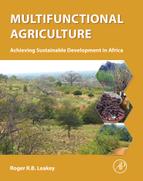Section 3. Importance of Tree Products
Many thousands of edible plants are wild and undomesticated, and many of them have been regularly consumed and highly appreciated by local people. As common property natural resources from the wild, the products of these species are said to be nontimber or nonwood forest products. Typically these species are much richer in nutrients than the few cereals and root crops that have been domesticated as staple foods on account of their carbohydrate content. The first paper reviews what is known about the nutritive values of the 17 species identified by African farmers as those of top priority for domestication in four ecoregions of Africa. Typically the published data are the mean values for each species, with little if any information about the extent of genetic variation in these values to guide the domestication process. Furthermore, there is seldom any information of the ranges of size, flavor, or indeed any traits that may be important to the trade or commercialization of the products.
The second paper presents data for two species (152 trees of Irvingia gabonensis and 293 trees of Dacryodes edulis) gathered from six villages in Cameroon and Nigeria. In addition to quantifying the extent of tree-to-tree morphological variation in a number of fruit and kernel traits, the frequency distribution of this data is examined with regard to a hypothesis that the range and frequency of variation in the different populations can be used to identify five stages of domestication. On the basis of the results of this study, D. edulis can be said to be virtually wild in Nigeria but semidomesticated in Cameroon, while I. gabonensis is wild in Cameroon and semidomesticated in Nigeria. With regard to the domestication of these species, this study clearly indicates both the perceived importance by local people of these species and the potential for phenotypic selection of different traits at the village level. The paper also recognizes the need for collaboration between agroforesters, farmers, and the food industry in initiatives to domesticate these species, both for local consumption and for larger-scale trade and for value-addition in wider-scale commercialization. The extension of these concepts is reported in later chapters.
In recognition of the role these species can play as new crops in the development of many tropical and subtropical countries through the actions of local farmers, the third paper proposes that the products should be known as “agroforestry tree products”. This name change reflects their origin as private property when cultivated on-farm, a change which should therefore exclude them from legislation governing products gathered from natural forests and woodlands. This name change will also allow their production to be incorporated into agricultural statistics.
